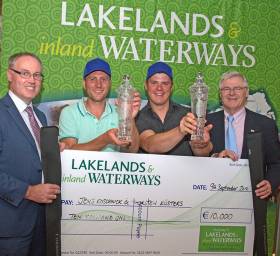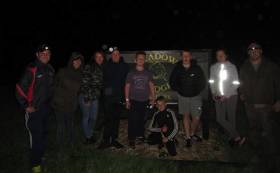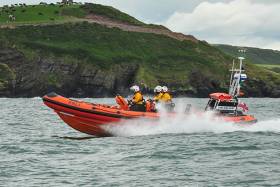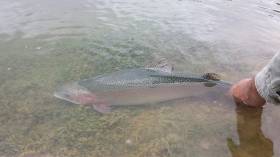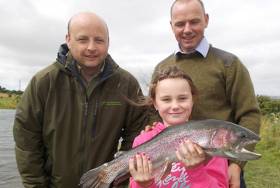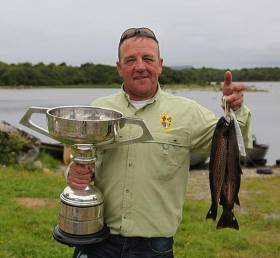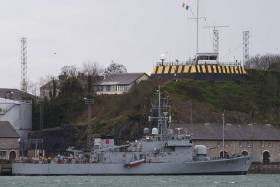Displaying items by tag: angling
German Anglers Take Top Prize in Lakelands & Inland Waterways World Pairs Angling Championships
German duo Jens Koschnick and Thorsten Kusters scooped this year’s Lakelands & Inland Waterways World Pairs Angling Championships title and the €10,000 prize In a week with some of the best weights seen in the five years of this competition the relative newcomers to the Irish scene held an impressive lead all the way through. Consistent fishing saw a second place finish from Ireland regulars Rod Scott and Michael Buchwalder pick up the €5,000 cheque in second place with the 2015 title holders and brothers Steve and Phil Ringer move up from 9th to 3rd place in a sensational finish to the competition.
As Afloat.ie reported previously, the Lakelands and Inland Waterways World Pairs Angling Championships is Ireland’s most prestigious coarse angling event and attracted almost 100 of the best anglers from Ireland, Europe & beyond and bringing over €150,000 into the local economy. The challenge of catching the natural wild fish so prolific in Ireland’s Lakelands, is one aspect of the Competition but the World Pairs has the added difficulty of doing so in partnership, with both angler's catches contributing to the overall weight for the daily and overall prizes. Run over 5 locations on both sides of the border over 5 days of competition the World Pairs is the ultimate in angling competitions!
Fáilte Ireland and Waterways Ireland have sponsored the World Pairs for the past five years, providing the top prizes with further support from Fermanagh-Omagh District Council & Cavan County Council. The active support of DAERA Inland Fisheries and Inland Fisheries Ireland has also been essential for a successful event with their expertise and resources in finding venues, preparing pegs, the bio-security measures and the stewarding for the events.
World Pairs Result
1: Jens Koschnick and Thorsten Küsters, 189.905 kg
2: Michael Buchwalder and Rod Scott, 174.010 kg
3: Phil Ringer and Steve Ringer, 168.790 kg
4: Will Freeman and Andy Leathers, 161.030 kg
5: Cathal Hughes and Philip Jackson, 156.550 kg
6: Nick Howell and Tommy Hillier, 154.055kg
7: Steve Fleming and Dean Barlow, 147.850kg
8: Lee Addy and Paul Keeley, 146.160kg
9: David Herron and James O’Doherty, 142.050
10: Darren Davies and Bob Nudd, 139.360kg
Dublin Angling Initiative Hosts First Night Fishing Event With Darndale Youth Group
#Angling - Inland Fisheries Ireland’s Dublin Angling Initiative (DAI) recently hosted its first nighttime fishing event at Meadow View Fisheries in Maynooth, Co Kildare.
A group of young people from Sphere 17 youth group in Darndale attended the event and fished for six hours from 7pm until 2am, enjoying good catches of roach, rudd and perch.
Nighttime angling equipment and techniques were introduced to the young people, who took little time to master the pursuit. During the event, the DAI also provided a barbecue to feed the hungry anglers.
The DAI aims to promote, develop and improve angling in the greater Dublin area. During the summer months, young people from national and secondary schools, summer projects and youth services are taken out on fishing courses.
To date, thousands of young people have been introduced to sea, coarse and game angling and the initiative has been a catalyst in setting up fishing clubs for many of these young people.
Oisin Cahill, DAI co-coordinator at Inland Fisheries Ireland (IFI), said: “Night fishing is an entirely different type of fishing, which the group from Sphere 17 had not experienced previously.
"We were delighted to show them the techniques required and provide them with the right equipment to enable them to try it out.
"Feedback on the night was very positive and another such event is already being planned."
The DAI welcomes enquiries from all groups or individuals interested in its programmes and services. For further information, visit www.fisheriesireland.ie or contact Oisin Cahill at [email protected]
World Pairs Angling Championships Underway
The Lakelands and Inland Waterways World Pairs Angling Championships, Ireland’s most prestigious coarse angling event has begun, attracting over 100 of the best anglers from Ireland, Europe & beyond and bringing over €150,000 into the local economy.
The challenge of catching the natural wild fish so prolific in Ireland’s Lakelands, is one aspect of the Competition but the World Pairs has the added difficulty of doing so in partnership, with both angler's catches contributing to the overall weight for the daily and overall prizes. Run over 5 locations on both sides of the border over 5 days of competition the World Pairs is the ultimate in angling competitions!
The angling zone for this event is the one hour zone from Killadeas to the North on Lough Erne and Garadice on the Shannon-Erne Waterway in Leitrim in the South. The cross border nature of the event is an important feature of the competition for the sponsors Lakelands & Inland Waterways, the tourism brand owned by Fáilte Ireland and Waterways Ireland. The excellence of the angling venues is ideal for the event, but it is their close proximity (max 30 minutes drive to the peg from the draw location) which allows this partnership event to work.
Failte Ireland and Waterways Ireland continue to sponsor the World Pairs, providing the top prizes with further support from Fermanagh-Omagh District Council & Cavan County Council. The active support of DAERA Inland Fisheries and Inland Fisheries Ireland is essential as they have the expertise and resources to finding venues, prepare pegs, the bio-security measures and the stewarding for the events.
Sharon Lavin, Head of Marketing, Waterways Ireland, stated "the Lakeland & Inland Waterways World Pairs has shone a spotlight on the high quality and large quantity of wild fish in Ireland's Lakelands. The international anglers coming to the event don't just come for the World Pairs, they stay for over a week, in local accommodations and enjoy the hospitality of our local restaurants and bars, and many stay on for a 2nd week to further enjoy the angling the area has to offer, easily adding over €150,000 to the local economy"
The Top prize of €10k and second prize of €5k are at the top of a full range of prizes including the DAIWA Cup, an individual entry competition running inside the Pairs with a full entry payout providing cash for 5 peg sections, daily by county and a top ten overall topped up by a massive £8,500 in tackle vouchers from DAIWA Sports Ltd.
Crosshaven RNLI Lifeboat Assist Anglers After Breakdown
Crosshaven RNLI Lifeboat in Cork Harbour was requested to launch yesterday evening at 9.45pm to reports of a speedboat broken down and adrift approximately one km south west of Trabolgan.
In calm conditions with a slight sea,the volunteer crew, under the command of Alan Venner with Ian Venner, Aoife Dinan and Vince Fleming on board headed to the area at best speed.
On arrival, the two anglers onboard the vessel had attempted remedial work with no results. The crew of the lifeboat then established a tow and landed the casualty at Crosshaven boatyard.
The lifeboat returned to station at 11.30pm and is currently being washed down and refuelled by the shore crew before being declared ready for service.
The Board of Inland Fisheries Ireland (IFI) met yesterday with a joint delegation from the National Anglers Representative Association and Trout Anglers Federation of Ireland to discuss IFI’s proposal to exit the production of trout for the re-stocking of angling lakes.
As a result of these discussions the Board of IFI has agreed to defer its proposal indefinitely. However, in the discussions the parties recognised that there are significant economic, environmental and biological issues surrounding the current production facilities which IFI needs to resolve. Inland Fisheries Ireland is committed to developing and seeking funding for a comprehensive strategy to meet current and future trout production needs, contingent on obtaining the significant investment required. The parties to the discussions agreed to continue to work closely together to deliver this strategy.
Young Anglers From Boyne Valley Enjoy Fishing Trip At Courtlough
#Angling - Members of the Boyne Valley Fishing Hub, which comprises clubs along the River Boyne with a focus on developing youth angling, enjoyed a fishing trip to Courtlough Trout Fishery earlier this month.
Some 30 experienced and novice anglers gave and attended lessons on fly fishing in the event, sponsored by Inland Fisheries Ireland (IFI), the Boyne Valley Fishing Hub and Courtlough Trout Fisheries Balbriggan, that was aimed at engaging potential young anglers in the Boyne Valley area.
Conditions on the day were difficult, but all anglers had success catching at least one fish each at the rainbow trout fishery, which consists of four acres of spring-fed lakes.
Topics covered during the fly fishing lessons included set-ups, fly choice and casting. Prizes were awarded at the end of the event to those who were particularly lucky on the day.
The event was facilitated as part of IFI’s Dublin Angling Initiative, which aims to promote, develop and improve angling in the greater Dublin area.
During the summer months, young people from national and secondary schools, summer projects and youth services are taken out on fishing courses.
To date, thousands of young people have been introduced to sea, coarse and game angling and the initiative has been a catalyst in setting up fishing clubs for many of these young people.
“It was fantastic to see so many anglers of different ages from Boyne Valley Fishing Hub take part in this trip," said Dublin Angling Initiative co-ordinator Oisin Cahill.
"Angling can be enjoyed at any age or ability and we are always welcoming young people who might be interested to consider trying it out."
Cahill added that the Dublin Angling Initiative "also engages young people around important issues such as conservation and the protection of our natural resources, which includes our fisheries.
"We hope this learning around biodiversity protection is something that will stay with them for the rest of their lives. We need to start engaging communities on these issues and getting the public out there to see what it is all about is a vital first step.”
For more on the Dublin Angling Initiative, visit www.fisheriesireland.ie or contact Oisin Cahill at [email protected]. For more information on Courtlough Trout Fisheries, contact Garrett on 0872712704. The Boyne Valley Fishing Hub can be found on Facebook HERE.
Young Anglers from Boyne Valley Enjoy Fishing Trip
Members of the Boyne Valley Fishing Hub recently enjoyed a fishing trip to Courtlough Trout Fishery. Almost 30 people took part in the event with experienced and novice anglers giving and attending lessons on fly fishing. The event, which was sponsored by Inland Fisheries Ireland, the Boyne Valley Fishing Hub and Courtlough Trout Fisheries Balbriggan, was aimed at engaging potential young anglers in the Boyne Valley Area.
Conditions on the day were difficult however all anglers had success catching at least one fish each at the rainbow trout fishery which consists of four acres of spring fed lakes. Topics covered during the fly fishing lessons included fly fishing set ups, fly choice and casting. Prizes were awarded at the end of the event to those who were particularly lucky on the day.
The event was facilitated as part of Inland Fisheries Ireland’s Dublin Angling Initiative which aims to promote, develop and improve angling in the greater Dublin area. During the summer months, young people from national and secondary schools, summer projects and youth services are taken out on fishing courses. To date, thousands of young people have been introduced to sea, coarse and game angling and the initiative has been a catalyst in setting up fishing clubs for many of these young people.
Oisin Cahill, Coordinator of the Dublin Angling Initiative at Inland Fisheries Ireland said: “It was fantastic to see so many anglers of different ages from Boyne Valley Fishing Hub take part in this trip. The Dublin Angling Initiative offers young people an opportunity to try out angling as a pursuit. Angling can be enjoyed at any age or ability and we are always welcoming young people who might be interested to consider trying it out.
The Dublin Angling Initiative also engages young people around important issues such as conservation and the protection of our natural resources, which includes our fisheries. We hope this learning around biodiversity protection is something that will stay with them for the rest of their lives. We need to start engaging communities on these issues and getting the public out there to see what it is all about is a vital first step.”
The Dublin Angling Initiative welcomes enquiries from all groups or individuals interested in its programmes and services. For further information, visit www.fisheriesireland.ie or contact Oisin Cahill, Dublin Angling Initiative Co-Coordinator by emailing [email protected] .
The Boyne Valley Fishing Hub is made up of clubs along the River Boyne including Navan, Trim and Bective with a focus on developing youth angling. For more information, visit the Boyne Valley Fishing Hub Facebook Page: https://www.facebook.com/groups/boynevalleyfishinghub/. For more information on Courtlough Trout Fisheries, contact Garrett on 0872712704.
Clare Angler Tops Trout Fly Worlds On Lough Mask
#Angling - Thomas O'Loughlin's impressive 12-fish catch was more than enough to snag him the top prize at the World Cup Trout Fly Angling Championship on Lough Mask recently.
The Corofin, Co Clare native's final bag of 13.43lbs was 50% larger than that of his closest rival Jonathan Craven of Connacht in the 60th running of the competition, which took place over five days ending on Monday 1 August, as the Clare Champion reports.
His victory marks the first for any Clare angler in the Lough Mask contest – but is just the latest in a series of accolades for 'Tommy', who comes from an experienced family of game anglers.
The Clare Champion has much more on the story HERE.
#Angling - The 1st Meath Adventure Scouts from Dunboyne and Sphere 17 youth group from Darndale in north Dublin recently participated in a visit on board the Irish Naval Service vessel LÉ Ciara.
During a short break in Dublin Port to refuel on 25 July, the ship's commanding officer gave kind permission for a visit on board, which was facilitated by the Dublin Angling Initiative (DAI) of Inland Fisheries Ireland (IFI).
The two youth groups were given a comprehensive tour of the ship, which included talks on naval duties, life at sea, navigation and weapon systems, fisheries protection and naval recruitment opportunities.
A key component of the DAI is to highlight the importance of fisheries conservation, and the initiative says visits aboard Irish naval ships are an extension of that sector.
DAI co-ordinator Oisin Cahill said: “We are delighted to work with the young people and youth leaders from 1st Meath Adventure Scouts and Sphere 17 Darndale. It is great to see the youth groups engage on the issue of conservation through enjoyable and interesting experiences such as this one.
"The Dublin Angling Initiative also introduces youths to the pursuit of angling. Angling is a wide and varied pursuit which can be sedentary or active, practiced socially or in solitude and appeals to a wide range of people of all ages including young people.
"We hope that by introducing these young people to angling, it might spark their interest and lead to them pursuing it as a hobby. It is vital that we engage communities around the aquatic landscape and encourage interest in important issues such as conservation and the environment.”
The DAI aims to promote, develop and improve angling in the greater Dublin area. During the summer months, young people from national and secondary schools, summer projects and youth services are taken out on fishing courses.
To date, thousands of young people have been introduced to sea, coarse and game angling, and the initiative has been a catalyst in setting up fishing clubs for many of these young people.
The DAI welcomes enquiries from all groups or individuals interested in its programmes and services. For further information visit www.fisheriesireland.ie or contact Oisin Cahill at [email protected].
Irish Water Prosecuted Over Midlands River Fish Kill
#FishKill - Inland Fisheries Ireland (IFI) has successfully prosecuted Irish Water over a chemical discharge on 18 August last year that causing a significant fish kill on a tributary of the Tullamore River.
At a sitting of Portlaoise District Court on Friday 15 July, Judge Catherine Staines heard evidence from Michael Fitzsimons, a senior fisheries environmental officer with IFI, that following a pollution report received from Irish Water, IFI carried out a detailed investigation on the Clodiagh River.
Over 3,000 fish mortalities were estimated over a 4km stretch of the river, consisting predominantly of trout along with other species such as salmon, lamprey, minnow and stoneloach.
The fish kill was as a direct result of a chemical discharge from an accident at the Irish Water plant in Clonsalee, Co Laois. Irish Water entered a guilty plea.
Judge Staines directed Irish Water to pay IFI’s legal costs of €5,016 and to cover the full cost of the rehabilitation works to be carried out downstream of the incident area. A development plan will be formulated by IFI in the coming weeks.
The judge did not impose a fine on the basis that it would be the Irish taxpayer paying for the incident. She also instructed Irish Water to carry out a full review of its Waste Water Treatment Plants (WWTP) and provide a report to her by 21st July 2017.
Judge Staines stated that she did not want to see an incident like this happening again.
“This was a serious pollution incident which will take a considerable number of years for the river to recover," said Amanda Mooney, Shannon River Basin District director with IFI.
"I am pleased with the outcome of the case and the provision for vital rehabilitation works to assist fish stocks to recover naturally.”
Judge Staines adjourned the case until 21 July 2017 to allow sufficient time for the rehabilitation works and WWTP review report to be concluded.
In other news, submissions are open for the consultation on plans to phase out fish farming at three of four IFI facilities it currently operates around Ireland.
As previously reported on Afloat.ie, operations in Roscrea, Co Tipperary; Cullion in Mullingar, Co Westmeath and Lough Allua in West Cork are affected by the restructuring plan.
Facilities at Cong in Co Mayo will be retained or research and stocking purposes, but rainbow and brown trout will no longer be farmed for sale.
Submissions should be made in writing before 5pm on Friday 19 August to [email protected] or Fish Farm Consultation, IFI, 3044 Lake Drive, Citywest Business Campus, Dublin D24 Y265.



























